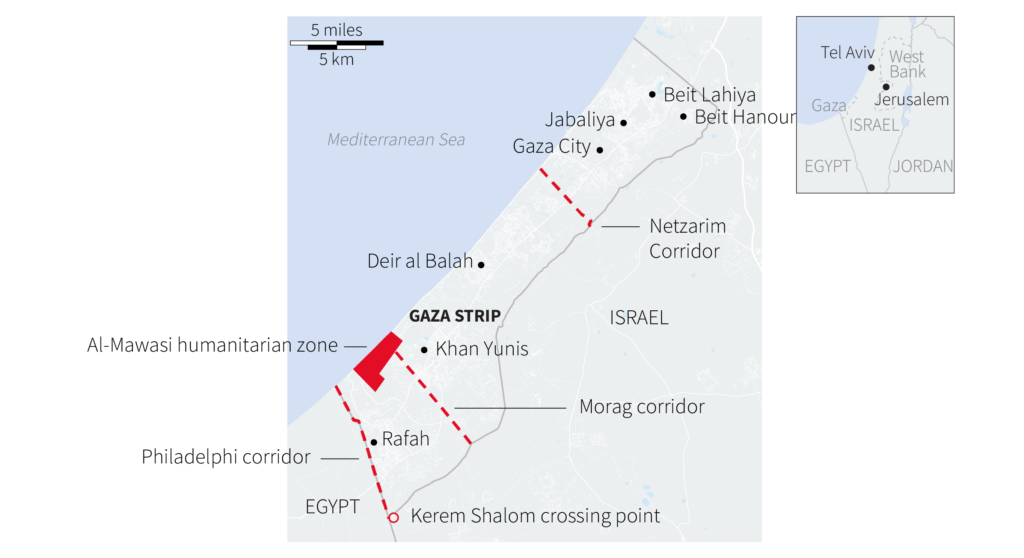On May 4, Israel’s security cabinet unanimously approved a comprehensive plan to dismantle Hamas’s remaining capabilities, both military and governmental, while offering Hamas a pause in exchange for a hostage release. The plan involves a large-scale call-up of reserves, a “clear and hold” strategy in parts of Gaza, and civilian evacuation as part of a new approach to humanitarian aid designed to separate Gazan civilians from Hamas terrorists.
As tens of thousands of reservists receive their “Order 8” (immediate call-up), details have emerged of the planned offensive, codenamed Gideon’s Chariots. Israel Defense Forces (IDF) chief of staff Eyal Zamir describes it as a “Phase B” in the ongoing war against Hamas.
Unlike the first 18 months of fighting in Gaza, when the Israeli military used raid-type tactics to move in and out of urban areas, Operation Gideon’s Chariots calls for three maneuver divisions to seize and hold enemy territory in southern, central and northern Gaza. In the prior phase, the IDF would clear an area of Hamas terrorists only to see them return once the IDF withdrew. Now Israel has the personnel to dedicate to this “clear and hold” campaign because the truce with Hizbullah in Lebanon appears to be holding.
At the same time, Israel is stating that Hamas has the option to pause this imminent campaign by accepting a proposal to release ten Israeli hostages in exchange for a temporary truce (which Prime Minister Netanyahu refers to as the Witkoff framework). Israel has reportedly conveyed a deadline to Hamas to accept this deal by mid-May (exact date unknown) coinciding with the end of President Trump’s visit to the Gulf.
The Hamas decision of May 12 to release Israeli – American IDF soldier Edan Alexander has not changed these dynamics at the time of this writing. Hamas has been demanding a full Israeli military withdrawal from Gaza and a permanent truce that would enable it to rebuild its military. For its part, Israel plans to remain in the expanded buffer zone around Gaza under any temporary or permanent ceasefire. This is deemed essential to protect Israeli border communities and prevent weapons smuggling into the Strip.
If the current impasse remains, Israel plans to move forward with Phase B. A protective firepower envelope from land, air, and sea – to neutralize explosives and terrorists – is planned to support the maneuvering forces.
A central and critical component of the offensive is the widespread evacuation of the Gazan civilian population from active combat zones, including those in northern Gaza, and from the al-Mawasi humanitarian zone west of Khan Yunis, to a new designated humanitarian areas in the southern part of the Strip, south of the Morag corridor.

This measure is intended to separate non-combatants and Hamas terrorists, affording the IDF greater operational freedom, while also ensuring that Hamas stops seizing humanitarian aid. The systematic theft by Hamas of humanitarian aid during the war has enabled its political regime to survive by monopolizing resources. Hamas is estimated to have around 20,000 terrorists remaining in active operation, while a similar number was likely killed so far, and thousands more injured.
What will the “Hold” part look like? Israeli officials describe a “voluntary transfer plan” for Gaza residents, particularly for those who move to the new southern humanitarian zone, outside Hamas’s direct control.
Only after the expanded operational activity begins and civilians are widely evacuated to the south will a distinct humanitarian plan, approved by the cabinet, be activated. The plan aims to differentiate between aid recipients and Hamas by utilizing civilian contractors for distribution within demarcated areas secured by the IDF. This includes the creation of a safe zone in the Rafah area, south of the Morag corridor, where individuals entering will be checked to prevent Hamas infiltration. IDF soldiers have been instructed not to distribute aid directly. Instead, designated zones will be managed by contractors with security measures to prevent diversion of aid to Hamas.
Alongside Operation Gideon’s Chariots, the Ministry of Defense began in March to build a new, multi-layered fortification system along the Gaza-Israel border, including a new concrete wall and an additional barrier, and to reconstruct the prior existing sensor fence and enhance the existing underground barrier.
Israel has already created a kilometer-deep buffer zone along the entire Israel – Gaza border. This zone is intended to deny Hamas cover for cross-border attacks, give the IDF critical time to protect nearby communities, and to serve as a future launch point for West Bank-style IDF raids. The IDF intends to maintain freedom of operation inside Gaza from this buffer zone and from the Morag and Netzarim Corridors in southern and central Gaza.
Even as these extensive preparations unfold, IDF operations continue across Gaza. These include airstrikes in the southern Strip, artillery fire on Hamas targets east of Gaza City on May 11 and 12, and the deployment of an armored division of reservists in the northern Strip and an armored conscript division together with the territorial Gaza division in the south.
Israel’s overarching goal is to establish a new security reality in which the IDF has full operational freedom in Gaza as it does in the West Bank and a defensive buffer zone. Israel has yet to articulate its role in a future for Gaza beyond these security measures. It appears to be borrowing from the US Army’s “clear, hold, build” counterinsurgency doctrine though without a “build” component.

